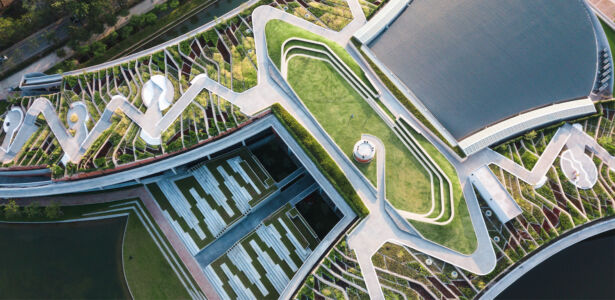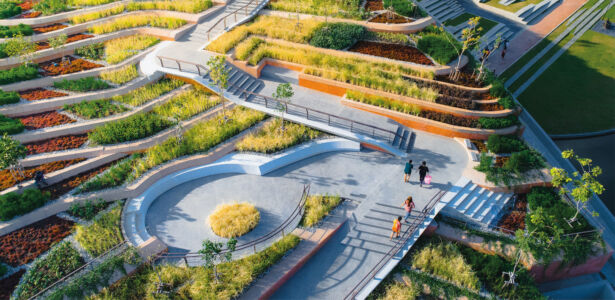Climate adaptation is no longer optional—it’s a necessity, especially in flood-prone areas coping with rising sea levels in urbanized environments. Bangkok is a prime example of a city that, due to rapid urbanization, has become increasingly vulnerable to water-related catastrophes, despite once thriving on its connection to water.
This is where landscape designer Thammasat Rooftop steps in. She has dedicated her career to finding landscape solutions to water issues while reviving Bangkok’s amphibious way of life, once known as the “Venice of the East.” Through her innovative projects, Voraakhom has earned a reputation as a leader in waterscape urbanism—a concept she has pioneered to promote water and landscape-based urbanism.
Voraakhom will be a featured guest at Utopian Hours, the international festival on city-making and urban innovation organized by Stratosferica, taking place from October 18 to 20 at La Centrale, Nuvola Lavazza, in Turin. She will join over 30 international speakers to present her landscape porosity concept and discuss why adapting to climate change is an urgent global priority.
Bangkok, Venice of The East
Situated on the floodplains of the Chao Phraya River, Bangkok, once celebrated as the “Venice of the East,” has an ever-shifting landscape shaped by its rivers and canals. Communities adapted to the wet and dry seasons, using boats for transport and trade. Traditional Thai homes were built on stilts, and floating markets emerged and dissolved with the tides, creating a dynamic, amphibious way of life.
Seasonal flooding is a key phenomenon for land creation. Shaped by the hydrological forces, Bangkok and The Lower Chao Phraya Delta define its symbolic identity as the “City of Three Waters”. Sculpted by the interaction of three vital water sources: rivers, rainfall, and the sea. These natural elements are not only essential to the city’s survival but have also deeply influenced its culture, history, and way of life, exemplifying people’s adaptability to their environment and the essential role water continues to play in Thai existence.
From water-based to a land-based city
Life in Bangkok’s water-based communities has drastically waned in just a few decades of rapid urban development. As urbanization accelerates, the lower delta has gradually lost its connection to the waterscape that once defined it. The city has forgotten its water communities and their adaptive ways of living. Shifting from canal to road, the vibrant, natural blue-green infrastructure that once characterized Bangkok’s amphibious way of life has faded into a distant memory.
Urban expansion has driven the city to fill in its waterways, severing canals from the communities that once thrived along their banks. This disconnection has declined the ecosystem services that these communities once relied on. Bangkok now bears little resemblance to its past. With over 1,500 canals covered and framed in concrete, these waterways, once vibrant arteries, have become stagnant, filled with sewage and embedded with grey infrastructure to hide the unsightly view.
The three hydrological forces—rivers, rain, and sea—that once nourished and sustained Bangkok’s delta now pose unpredictable climate threats. Severe flooding, extreme drought, and creeping saltwater intrusion have disrupted the once-balanced water cycles. In 2011, when unexpected heavy rains from northern Thailand flowed toward the lower delta, Bangkok—often referred to as the “City of Three Waters”—was unprepared to handle the deluge. The natural flow of water was obstructed by the city’s concrete urban sprawl, turning what could have been manageable flooding into a catastrophic disaster.
By 2050, if carbon emissions and global warming continue at their current rate, the IPCC projects global sea levels to rise by 33 cm. Coupled with Bangkok sinking at a rate of 1-2 cm per year due to its foundation on the soft alluvial soils of the Chao Phraya River Delta, Thailand has been identified as one of the countries most at risk, according to the Global Climate Risk Index. Rising sea levels could impact three times as many people as previously predicted, threatening to inundate many of the world’s great coastal cities, including Bangkok.
Landscape Porosity: Why We Need Water-Based Urbanism
Urban areas are increasingly prone to flooding due to climate change, rising urbanization, and inadequate stormwater management. An estimated 1.81 billion people, or 23% of the world population, are directly exposed to a 1-in-100-year flood event, posing significant risk to lives and livelihoods. (World Bank).
As urban flooding becomes the new normal, aligning urban development with an evolving and unpredictable climate is essential. The “landscape porosity” concept encourages cities to harmonize with natural water flows, emphasizing flexibility and climate resilience. This involves creating breathable urban spaces for water and wind.
The Landprocess and Porous City Network (PCN) defend and expand green spaces through trees, parks, wetlands, and ponds, vital for enhancing urban resilience. Bangkok, with one of the lowest public green space ratios, urgently needs to reclaim every square meter of green space.
Living with Water: Landscape-Based Urban Solutions
Creating urban spaces that allow for the free flow and penetration of water and wind is essential to the survival of water-based cities like Bangkok. “Landscape porosity” can help us better understand and defend these urban ecosystems in times of climate change.
The Thirsty Park: Chulalongkorn Centenary Park. An 11-acre green space, it collects and holds water, mitigating flood risks. Its design features sustainable drainage systems, a green roof, and wetlands, turning every drop of rain into a resource.
Mimic the local wisdom: Thammasat Urban Farm. Asia’s largest organic rooftop farm, this project integrates landscape architecture with traditional rice terraces, providing a circular economy for the campus while enhancing water management and public space.
Rethink infrastructure: Chao Phaya Sky Park (CPSP). Built on abandoned infrastructure, this green space connects Bangkok’s historical and modern districts. It exemplifies adaptive reuse, enhancing public health and providing much-needed green areas.
From Sewage to Green Canal nature-positive Living: Chong Nonsi Canal Park. This project revitalizes a neglected canal, integrating blue-green spaces into Bangkok’s urban fabric. It’s a key step toward a more resilient, water-positive city.
Make Government more humane: Thailand Government Complex. A low-carbon urban model, this transformation includes an elevated walkway and a rooftop park, enhancing public transport and green spaces, while promoting rain harvesting.
Waterscape Urbanism: The Way Forward
How many porous parks do we need to sustain a city and prevent flooding? The answer lies not in the number of parks but in our commitment to returning, reclaiming and regenerating our natural waterscape. This is not just an option; it is the only path to survival. Understanding our historical resilience and adaptive living with water is crucial, particularly in the context of waterscape urbanism needed for Bangkok’s future on the Chao Phraya River Delta. To keep our water-based city afloat, we must prioritize the revitalization of our canals, floodplains, and once-porous lands, integrating them with our development as we move forward.
Urban development is inevitable, and no city is yet sustainable. As the population continues to rise, climate change presents an enigmatic puzzle. This presents us with boundless opportunities that we need to ensure adaptive solutions for climate-ready.
Immagine copertina: Thammasat Rooftop, Kotchakorn Voraakhom, Bangkok





























